Allocation Paths
Allocation Paths are a core part of our dynamic allocation technology that allow you to create multiple different paths through your entity structure by picking a different Allocation Rule at each entity through the path. This results in a unique path to the ultimate beneficiary owners that can be used for allocating Transactions and other underlying items.
Allocation Path Features
Allocation Paths are incredibly flexible and enable multiple ways of re-use to ensure the minimum amount of work need occur when determining how to allocate a transaction using a path.
An Allocation Path starts with an Entity in an Entity Set (Such as a Company Structure [more info]) and choosing which Allocation Rule to use on that Entity to allocate anything to.
If this entity is the ultimate owning company and allocates straight to its ultimate owners then the Path essentially only consists of this entity and rule.
If there are parent entites above this subsidary entity then for every entity in the structure that is allocated to in the rule the Path advances along that route. For each of those entities above the original entity, you again choose a rule for allocating from that entity, and so on until you have allocated to every ultimate owner at the top of the allocation.
Tip
What you have created is a unique Path, that can be used to allocate any transactions at any of the entities along the structure of the path up to the ultimate owners. This Path is visually simple, and can be re-used at every level of the Path to give percentage allocations from that entity through the structure to the ultimate owners.
Example For instance, if you had entities and rules in your structure of the following:
- Hold Co
- Rule "HOLDCO" Allocating to Owners
- Regulated OpCo
- Rule "OPCO" Allocating 100% to HoldCo
- CoParticipation SPV
- Rule "COSPV" Allocating to Owners
- Asset Management SPV
- Rule "AMSPV" allocating 80% to RegulatedOpCo, and 20% to CoParticipation SPV
- Unregulated OpCo
- Rule "UCO" allocating 100% to HoldCo
You could create a path like so:
- Asset Management SPV - Rule AMSPV
- Regulated OpCo - Rule OPCO
- Hold Co - Rule HOLDCO
- Regulated OpCo - Rule OPCO
- Co Participation SPV - Rule COSPV
This would be visually represented in the system like so:

(See our Entity Structure View for details of automatically visualising structures and paths)
Path Use
The system uses the GetPathInfo SQL Wrapper to automatically get the percentages from any given path. These percentages are calculated to be multiplied directly against any entity in the path to give the final percentages through the structure, from that entity, all the way to the top allocations.
So for instance in the above example the GetPaths SQL Wrapper would return the following:
- Allocations from Asset Management SPV that can be directly multiplied to give the final percentages to the ultimate owners in Co Participation SPV and Hold Co (via all the percentages up the path to both those final entities in the structure)
- Allocations from Co Participation SPV that can be directly multiplied to give the final percentages to the ultimate owners in Co Participation SPV.
- Allocations from Regulated Op Co that can be directly multiplied to give the final percentages to the ultimate owners in Hold Co
- Allocations from hold Co that can be directly multiplied to give the final percentages for the ultimate owner in Hold Co
By calculating the percentages from each entity in the path directly to the ultimate owners this provides an easy mechanism for the system to re-use this path allocations for mass allocation calculations. For instance all transactions occurring against any Instruments that are mapped to this Path (regardless of which entity owns the instrument) can simply take this path information and multiply from the entity straight to the final allocation percentages. This greatly reduces the amount of rules, paths, mappings, etc that need to be configured and also the amount of work the system has to do to calculate allocations.
Tip
In essence by re-using a Path throughout your entire structure wherever it is needed the system can easily calculate final allocations for every transaction using that path pretty much instantly.
Include In Entity Allocations
As can be ascertained from the example above a Path has a concept of a "top level" entity, or a "Root Entity". This is the entity at the top of the structure that allocates to the ultimate owners, and not to anymore entities within the structure itself. You can of course have more than one "Root Entity", as is the case in the above example where we have CoParticipation SPV and HoldCo as Root Entities that allocate to their respective ultimate owners.
However it is possible, for tax and other purposes, that you do have entities above these "Root Entities" but they are only for the purpose of blocking tax and similar requirements. In these cases we still want to see that an ultimate owner is being allocated to via a "Root Entity" even if that ultimate owner is actually in a vehicle above the "Root Entity".
For instance, in this example we have "Blocker A" and "Blocker HoldCo" that sit above the Root Entity AIV II:

In this case we want the allocations to allocate to the ultimate owners in Blocker HoldCo, but we also want it to allocate the correct amounts to facilitate that to Blocker A and Blocker Hold Co as well. In this scenario we can utilise the "Include Entity In Allocation" option in the Allocation Path Rule.
This ensures when the system calculates the allocations it also calculates allocations that directly allocate to the vehicles marked with "Include Entity In Allocation" as well. So for instance, if there was one ultimate owner in Blocker Hold Co who received 5% of the allocation then the allocation amounts Aquisition Vehicle would look like this:
- 95% to Ultimate Owning Entities from AIV II
- 5% to Blocker A via from AIV II
- 5% to Blocker Hold Co from Blocker A
- 5% to Ultimate Owner in Blocker HoldCo from Blocker Hold Co
Note
All of these allocations would still have the same Root Entity of AIV II, it's just that some of the ultimate owners belong in shielded vehicles above.
System Usage
The system uses the Path if it is directly specified in a Transaction, or if the Transaction is against an Instrument and the system can use Allocation Mappings to determine the unique Path to use for that Instrument. In either case, when it has the Path it can automatically allocate all those transactions accordingly.
By linking Paths dynamically to Instruments we provide a versatile, dynamic and configurable mechanism for allocations throughout your structure. You don't have to specify allocations at the time of creating a Transaction, or Instrument. They can simply sit in the system as Transactions the system is unable to allocate. When you have the information later you can then assign mappings to ensure those transactions will be dynamically allocated correctly when required
The massive advantage of this approach over sticking allocations with transactions, or instruments, is the flexibility. You don't have to know everything at the time of transactions, and you don't need to cancel transactions and redo you're work if allocations have been set up incorrectly. You can always modify these later as required.
Important
The system can warn you about Transactions, and Instruments it does not know how to allocate, or any other problems with mappings in general. So you never need worry about whether everything is setup correctly if you are leaving allocations and mappings till period ends or other dates.
Views
Allocation Paths are managed through the following views: